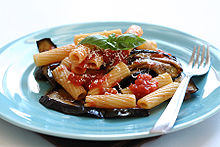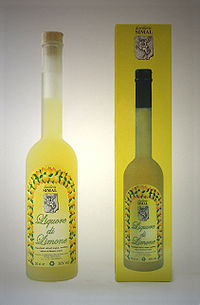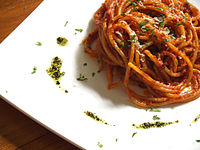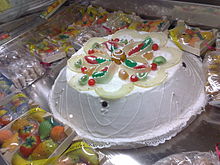- Sicilian cuisine
-
Sicilian cuisine shows traces of all the cultures which established themselves on the island of Sicily over the last two millennia.[1] Although its cuisine is predominantly based on Italian cuisine, Sicilian food also has Spanish, Greek and Arab influences.
Contents
History
The use of apricots, sugar, citrus, sweet melons, rice, saffron, raisins, nutmeg, clove, pepper, pine nuts, cinnamon (along with fried preparations) is a sign of Arab influences from the Arab domination of Sicily in the 10th and 11th centuries.[2]
Normans and Hohenstaufen influences are also found, such as in the fondness for meat dishes, such as Bruscialoni.[3] Later, the Spanish introduced numerous items from the New World, including cocoa, maize, peppers, turkey, and tomatoes and other produce.[4] In Catania, on the east coast, initially settled by Greek colonists, fish, olives, broad beans, pistachio and fresh vegetables are preferred instead. Much of the island's cuisine encourages the use of fresh vegetables such as eggplant, peppers, and tomatoes, and fish such as tuna, sea bream, sea bass, cuttlefish, and swordfish. In Trapani in the extreme western corner of the island, North African influences are clear in the use of couscous.
Dishes
 Arancine from Ragusa, Sicily. Arancine are fried or (less often) baked rice balls usually filled with ragù (meat sauce), tomato sauce, mozzarella, and/or peas, and then coated in bread crumbs.
Arancine from Ragusa, Sicily. Arancine are fried or (less often) baked rice balls usually filled with ragù (meat sauce), tomato sauce, mozzarella, and/or peas, and then coated in bread crumbs.
 The Catanese dish Pasta alla Norma is amongst Sicily's most historic and iconic
The Catanese dish Pasta alla Norma is amongst Sicily's most historic and iconic
Dishes from Sicily include arancine (a form of deep-fried rice croquettes), Pasta alla Norma (a specialty of Catania), caponata, pani ca meusa (Palermo) and couscous al pesce (Trapani). Manicotti is another common dish.
Desserts and sweets
Sweets are another specialty; examples include: frutta martorana, pignolata, buccellato, cannolo siciliano, granita, and cassata siciliana. Granita is particularly famous and well known. It is a semi-frozen dessert of sugar, water, and flavorings originally from the island, and is commonly associated from Catania, even though there is no evident proof that it hails from the particular Sicilian city. Related to sorbet and italian ice, in most of Sicily it has a coarser, more crystalline texture. Food writer Jeffrey Steingarten says that "the desired texture seems to vary from city to city" on the island; on the west coast and in Palermo, it is at its chunkiest, and in the east it is nearly as smooth as sorbet.[5] This is largely the result of different freezing techniques: the smoother types are produced in a gelato machine, while the coarser varieties are frozen with only occasional agitation, then scraped or shaved to produce separated crystals.
Fruits
Sicily uses citrus fruits in their cuisine. Many were first introduced by the Arabs from the 9th to 11th centuries, but some have been brought more recently to the region as well such as the Washington navel from Brazil. Examples of the citrus fruits found in Sicily:[6]
- Biondo comune - the "common blonde" orange
- Ovale - ripens between April and May, with a compact flesh
- Sanguigno comune - common blood orange harvested between January and April
- Washington navel - introduced from Brazil during the 1940s-1950s, grown chiefly near Ribera and Sciacca and harvested from November to January
- Sanguinella - bitter orange of the blood orange variety, found in Paternò Santa Maria di Licodia, Palagonia, Scordia and Francofonte during January until April
- Tarocco - high quality blood orange found in Catania, Siracusa and Francofonte from November to January
- Tarocco dal muso - bell shaped orange found in Francofonte
- Valencia - similar to the Ovale and used often in confectionary items
- Moro - crimson colored flesh found in Lentini, Scordia, and Francofonte from mid-January until the end of April
- Comune - common variety of the mandarin orange
- Tardivo ciaculli - a second variety of the mandarin orange found in Sicily
- Femminello - the lemon that makes up 80% of Sicily's lemon crop, sound in Catania, Siracusa, Messina and Palermo
- Monachello - "little monk lemon harvested from October from March and able to withstand drought better that the Ferrminello
- Verdello - a lime that grows particularly well and is harvested from May to September
Wines and drinks
 Limoncello is a popular and strong lemon liquer often associated with Sicilian food and drink.
Limoncello is a popular and strong lemon liquer often associated with Sicilian food and drink.
For the main meal Sicilians drink mostly wine. The soil and the climate in Sicily are ideal for growing grapes, mainly due to Mount Etna, and a wine-making tradition on the island has operated since the Greeks set up their first colonies on the island. Today, all provinces of the island produced wine and wine by the introduction of modern methods of Sicily established itself on the European wine market.
Sicilian red wines have an alcoholic content of 12.5 to 13% and are usually drunk in the evening with roast or grilled meat. Well-known red wines include the Cerasuolo di Vittoria, the Nero d'Avola mainly those product around Noto (Siracusa). The dry and white wines and rosés usually have an alcoholic content from 11.5 to 12% and are mainly taken with fish, poultry and pasta dishes.
In addition, various dessert wines are produced, such as the famous Marsala, the Malvasia delle Lipari.
More typical Sicilian drinks are the limoncello, a lemon liqueur, and the Amaro Siciliano, a herbal drink, which is often consumed after meals as a digestive.
See also
References
- ^ Sicilian food history umass.edu
- ^ Piras, 423.
- ^ Bruscialoni recipe
- ^ Piras, 423.
- ^ Steingarten, Jeffrey (1997). "The Mother of All Ice Cream". The Man Who Ate Everything. Vintage Books. pp. 361–380. ISBN 0-375-70202-4. The chapter is an essay first published in June 1996.
- ^ Piras, Claudia and Medagliani, Eugenio. Culinaria Italy. Cologne: Könemann Verlagsgesellschaft mbh, 2000. pages 440-441.
Cuisine of the Mediterranean Northern Africa Southern Europe European regions Western Asia  Sicily
SicilyProvinces
and places
History Politics and
governmentCulture and
heritageCuisine • Language • People • Music • Sicilian Baroque • Sicilian School • Sicilian cart • Coppola • Flags • Triskelion • Mount Etna • Chestnut Tree of One Hundred HorsesCategories:- Sicilian cuisine
- Italian regional cuisines
Wikimedia Foundation. 2010.




